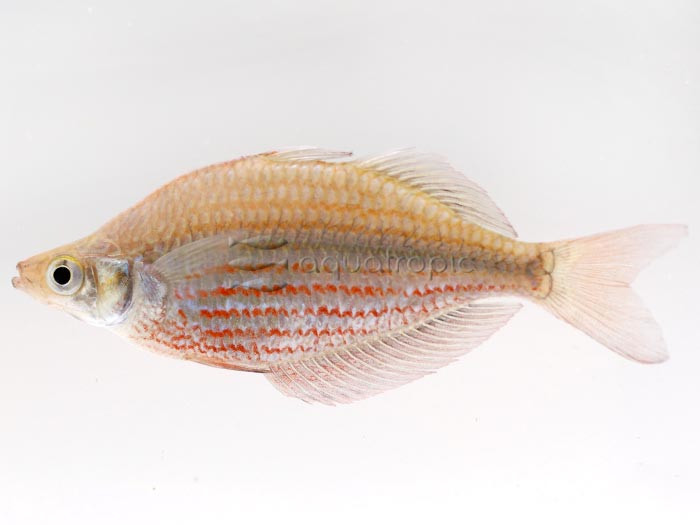Grimé Rainbowfish (Glossolepis dorityi)

No, there’s nothing especially grimy about this colorful rainbowfish. Quite far from it, actually. The red scale rows of this fish make for a beautiful addition to any community aquarium, and offer an interesting alternative to the familiar Salmon-red Rainbowfish (Glossolepis incisus).
The Glossolepis rainbowfishes are all endemic to the island of New Guinea, with each of the nine recognized species limited to particular lakes or river drainages. You’ll find G. incisus lurking in Lake Sentani, a small body of water situated near to the northern coast, roughly where the Indonesia side of the island (West Papua) meets the eastern half (Papua New Guinea). Travel about 20 miles due west, and you’ll encounter a slightly different reddish species, G. pseudoincisus, living in an oxbow of the Tami River. But travel another 20 miles or so, and you’ll find yourself at the Grimé River, home to G. dorityi.
More specifically, the type locality is something called Lake Nenggwambu (AKA Lake Kali Biru), which is said to have an outlet into the nearby river, but no obvious inlet. Instead, this lake is fed through underground sources coming up through a porous limestone that this portion of New Guinea sits upon. All of these Glossolepis appear to be strictly associated with standing bodies of water, despite the many streams that surround them. The only other reported location for this rainbowfish is Lake Jaigum.
It’s interesting to watch evolution in action here. With each successive body of water, we see the resident fishes shift ever so slightly from the silvery-reds of Lake Sentani to the greenish and red of the Grimé Rainbowfish. Though these species are each fairly abundant in their natural habitats, they are nonetheless vulnerable to the dangers of habitat loss and exploitation given their minute geographic ranges and generally small population sizes. Fortunately, aquarium specimens are now commercially produced thanks to the considerable efforts of a small handful of dedicated aquatic explorers who have helped bring these obscure creatures to light… one of these being Dan Dority, who helped collect the first specimens of this one.
As with any of the larger rainbowfishes (max size here is about 4 inches in males), you’ll ideally want to keep G. dorityi in groups, with a few more females than males. The fairer sex is a bit less-colorful, lacking the orangish hue of their suitors, but you’ll need them around to see this fish at its fullest potential. For those wishing to recreate their natural habitat, the Barred Rainbowfish (Chilatherina fasciata) is also said to be common in these lakes, and it too can be encountered in the aquarium trade.